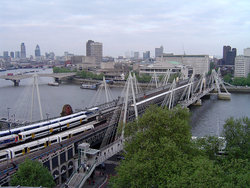Hungerford Bridge
|
|
Missing image Hungerford.bridge.arp.750pix.jpg Hungerford Bridge seen from the London Eye observation wheel |
Missing image Hungerford_night.jpg The footbridge at night |
Missing image Golden_jubilee_bridge.jpg Detail of Golden Jubilee Bridge |
Hungerford Bridge is a bridge (or triplet of bridges) over the River Thames in London, between Waterloo Bridge and Westminster Bridge. In its current design, it comprises a steel truss railway bridge - sometimes known as the Charing Cross Bridge - flanked by two cable-stayed pedestrian bridges that share the railway bridge's foundation piers, and which are properly named the Golden Jubilee Bridges.
The south end of the bridge is near Waterloo station, County Hall, the Royal Festival Hall, and the London Eye. The north end is near Embankment tube station, Charing Cross railway station and the Victoria Embankment.
History
Hungerford Bridge was originally designed by Isambard Kingdom Brunel and opened in 1845 as a suspension footbridge. In 1859 it was bought to extend the South Eastern Railway into the newly opened Charing Cross railway station. The railway company replaced the suspension bridge with a structure designed by Sir John Hawkshaw, comprising nine spans made of wrought-iron lattice girders. The chains from the old bridge were re-used in Bristol's Clifton Suspension Bridge.
Walkways were added on each side, with the upstream one later being removed when the railway was widened. In 1951 another walkway was temporarily added when an Army Bailey bridge was added for the Festival of Britain. It is the only bridge in central London to combine pedestrian and rail use.
The footbridge gained a reputation for being narrow, dilapidated and dangerous at night. In the mid 1990s a decision was made to replace the footbridge with new structures on either side of the existing railway bridge, and a competition was held in 1996 for a new design. It was won by architects Lifschutz Davidson and engineers WSP Group, and the two new 4-metre wide footbridges were completed in 2002. They were named the Golden Jubilee Bridges, in honour of the fiftieth anniversary of Queen Elizabeth II's coronation, although in practice they are still referred to as the "Hungerford Footbridges".
The new footbridges
The new footbridges posed a considerable engineering challenge. Their construction was complicated by the need to keep the existing railway bridge operating without interruptions. There was also the problem of the Bakerloo Line tunnels passing only a few feet under the river bed as well as the potential danger of unexploded bombs lurking in the Thames mud. The 300m-long decks were raised using an innovative method called incremental launching, in which each 50m-long section was pulled across the river using a 250m-long steel truss weighing 300 tonnes. This process was repeated five times until each deck spanned the river, supported by six temporary piers made of steel and concrete. The seven 25-tonne pylons were then raised over the subsequent two weeks. Once the pylons had been installed, the decks were jacked up to enable their connection with the cable stays suspended from the pylons. The concrete deck was then lowered into its final position and the temporary piers and supports were dismantled.
The design of the bridges is extremely complex. Each of the two decks is supported by inclined outward-leaning pylons. The decks are suspended from fans of slender steel rods called deck stays - there are 180 on each deck, made up of over 4 km of cable - and are held in position by other rods called back stays. Because the pylons lean, the back stays are under tension. The deck is secured in place by steel collars fitted around (although not supported by) the pillars of the railway bridge; the collars are themselves attached to the bridge's foundations by tie-down rods. The entire structure is thus held in place by exploiting the tensions between the pylons and the various stay rods and struts.
The new bridges won the Specialist category in the Royal Fine Art Commission Building of the Year Award in 2003. It gained a Structural Achievement Award commendation in the 2004 Institution of Structural Engineers awards, and has won awards from the Civic Trust and for its lighting design.
External links
Template:Mmuk maphot The photo was taken prior to the construction of the Golden Jubilee Bridges. It also shows the London Eye under construction and in an horizontal position.
| Bridges of Central London, west to east |
|---|
| Chelsea Bridge | Grosvenor Bridge | Vauxhall Bridge | Lambeth Bridge | Westminster Bridge |
| Hungerford Bridge | Waterloo Bridge | Blackfriars Bridge | Blackfriars Railway Bridge |
| Millennium Bridge | Southwark Bridge | Cannon Street Railway Bridge | London Bridge | Tower Bridge |
| See also: Crossings of the River Thames | Bridges of the United Kingdom |

